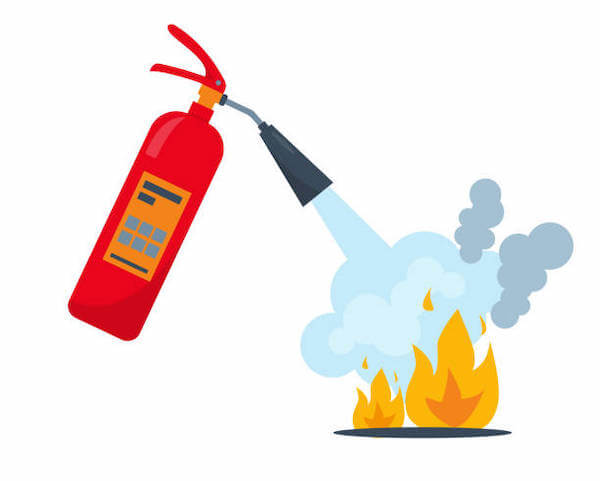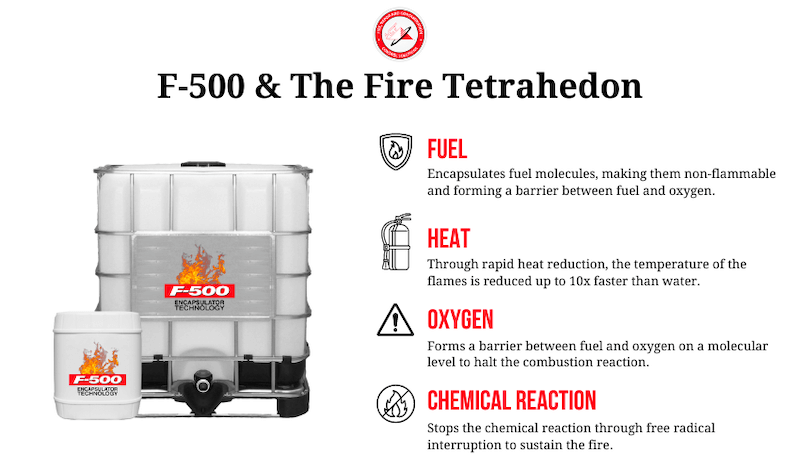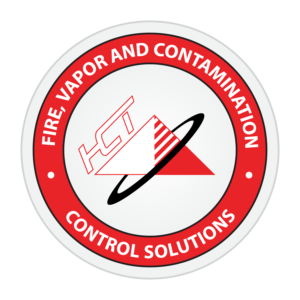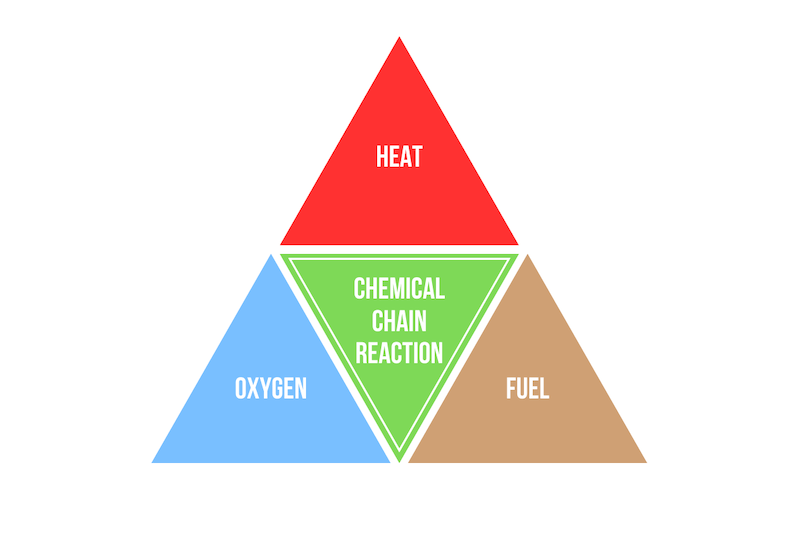The fire tetrahedron is a key part of suppression solutions and fire safety. This model builds on the traditional fire triangle by introducing a critical fourth element: the chemical chain reaction. Fire suppression systems are developed to combat these elements, focusing on disrupting the chain reaction that keeps fires burning.
The Basics of the Fire Triangle
The fire triangle, also known as the combustion triangle, represents the fundamental elements required for combustion. This model, simple yet effective, consists of three critical components:
- Fuel
- Heat
- Oxygen
Each element plays an important role in sustaining a fire, and their interaction with each other forms the basis for the ignition and maintenance of various fire classes.
Fuel
Fuel is any combustible material that a fire uses to keep itself going. Different materials are considered fuel sources, such as paper, wood, fabrics, liquids, gases, plastics, and rubber. The type of fuel present can significantly affect the fire’s temperature, speed, and overall behavior.
Heat
This acts as the ignition point, providing enough heat and energy to increase the temperature of the fuel to a level where combustion can occur. Heat also plays a role in determining the material’s flash point, which is the lowest temperature for a liquid’s flammability. The fire hazard is more severe with a lower flash point. This element is crucial because, without sufficient heat, even the most flammable materials won’t ignite.
Oxygen
Oxygen, which makes up about 21% of the Earth’s atmosphere, is the driving force of the fire. Most fires only need at least 16% oxygen to burn. This oxidizing agent supports the chemical reactions that release heat from the burning fuel in fires.
Understanding the role each component plays in sustaining a fire highlights the strategy behind effective fire suppression — remove any one of these elements and the fire can be extinguished. Removing fuel can be achieved by soaking the flames with water or creating a fuel break to control the spread of fire. Eliminating the heat source involves cooling the fire below its ignition point. This can be done with water or with a fire extinguisher. The oxygen supply can be removed by smothering the fire with a fire blanket, using fluorine-free foam, or displacing the air with carbon dioxide to effectively halt the combustion process.
By targeting these essential elements, fire suppression strategies become more precise, ensuring a safer and more effective response to the complex fire hazards we face every day.

From Triangle to Tetrahedron: A Complex Model for Fire Suppression
The fire tetrahedron enhances the traditional three-element concept by introducing a critical fourth component: the chemical reaction. This addition shifts our approach from controlling external factors to engaging directly with the fire’s behavior.
The chemical reaction element acknowledges that fire is not just a physical but a chemical process. It involves a complex reaction between fuel and oxygen. This reaction then releases heat energy, keeping the cycle of combustion continuing.
Challenges Presented for Fire Suppression
This enhanced model further demonstrates the challenges seen in modern fire suppression. The presence of synthetic materials introduces new chemical reactions that make fires hotter, faster, and more difficult to control than ones with natural materials. Advanced technologies in the environment, such as electric vehicles, lithium-ion batteries, and other electrical equipment, are also extremely flammable and more difficult to tackle.
Traditional suppression methods that target only the basic elements of fuel, heat, and oxygen may not be as effective against the intricate chemical processes that now characterize many fires.
Understanding the fire tetrahedron is crucial for developing innovative suppression solutions that are capable of interrupting these complex reactions. It drives the creation of specialized agents designed not just to cool the fire, but to chemically alter the combustion process on a molecular level.

How the Fire Tetrahedron Influences Fire Suppression Strategies
Understanding how the components of the fire tetrahedron work together improves how we approach fire suppression, leading to targeted strategies for each of its components: fuel, heat, oxygen, and chemical reaction. The F-500 Encapsulator Agent (EA) is a revolutionary solution that addresses all four elements of the fire tetrahedron simultaneously. It cools the fire, encapsulates the fuel, reduces the amount of oxygen, and lastly, interrupts the chemical reaction.
Encapsulating the Fuel
The F-500 EA encapsulates the fuel molecules, rendering them non-flammable and interrupting the fuel element of the tetrahedron. It achieves this by forming a barrier that keeps fuel and oxygen apart, ensuring the fire cannot reignite.
Cooling the Fire
Encapsulator Technology is extremely efficient at absorbing heat. Through a rapid heat reduction process, the ignition temperature of the flames is quickly reduced. This occurs up to 10 times faster than water alone. This cooling process directly combats heat, removing one of the fire’s essential elements.
Reducing the Oxygen
The next step is forming a molecular barrier between the fuel source and the oxygen. This significantly interrupts oxygen’s role in keeping the fire alive because it’s needed to support the combustion reaction.
Interrupting the Chemical Reaction
Critical to its effectiveness, this extinguishing agent stops the chemical chain reaction that is necessary for combustion. This is done through free radical interruption. Halting these reactions means directly addressing the fire at a molecular level.
Encapsulator Technology marks a significant advancement in fire suppression technology. It’s not just a foam that physically blocks oxygen from a fire. While a traditional foam system works on a mechanical level, the F-500 EA operates at a chemical molecular level. It changes the composition of the water it’s mixed with to ensure a comprehensive approach to fire suppression.
Several key features make the Encapsulator Agent stand out from typical foam or dry chemical systems:
- Encapsulate polar and non-polar fuels on a molecular level.
- Create a thermal circuit that forms an outer layer on each water droplet, driving the heat into the inner part of the water.
- Interrupt the chemical chain reaction by absorbing free radical energy
- Fluorine-free, biodegradable, non-corrosive, and contains no PFOA or PFAS.
This technology is the perfect solution for today’s complex fire challenges. It’s effective against various fire classes, including Class A, Class B, Class D, and lithium-ion battery fires. Whether mitigating fires involving solid materials, flammable liquids, or gases, the F-500 EA meets and exceeds the needs of the industry.
Hazard Control Technologies: Leading with Innovation and Expertise
At Hazard Control Technologies, we are leaders in Encapsulator Technology fire protection. Our mission is to safeguard lives and property by offering top-quality suppression solutions for organizations across various industries. Our commitment to excellence is reflected through our ISO 9001 certification, which ensures that every product or piece of equipment we provide meets the highest standards of quality and effectiveness.
With our innovative research and expertise, we have developed specialized fire extinguishers and agents like the F-500 EA, addressing complex fire challenges with scientifically advanced and environmentally responsible solutions. If you’re ready to take your organization to the next level with our fire suppression strategies, contact us or request a quote today! Let’s set new standards in fire safety together.
Resources:
- Hazard Control Technologies. https://hct-world.com/
- “Reports Guide: All About Fire.” National Fire Protection Association. https://www.nfpa.org/about-nfpa/press-room/reporters-guide-to-fire/all-about-fire
- “The Fire Triangle.” University of South Carolina. https://www.sc.edu/ehs/training/Fire/01_triangle.htm



